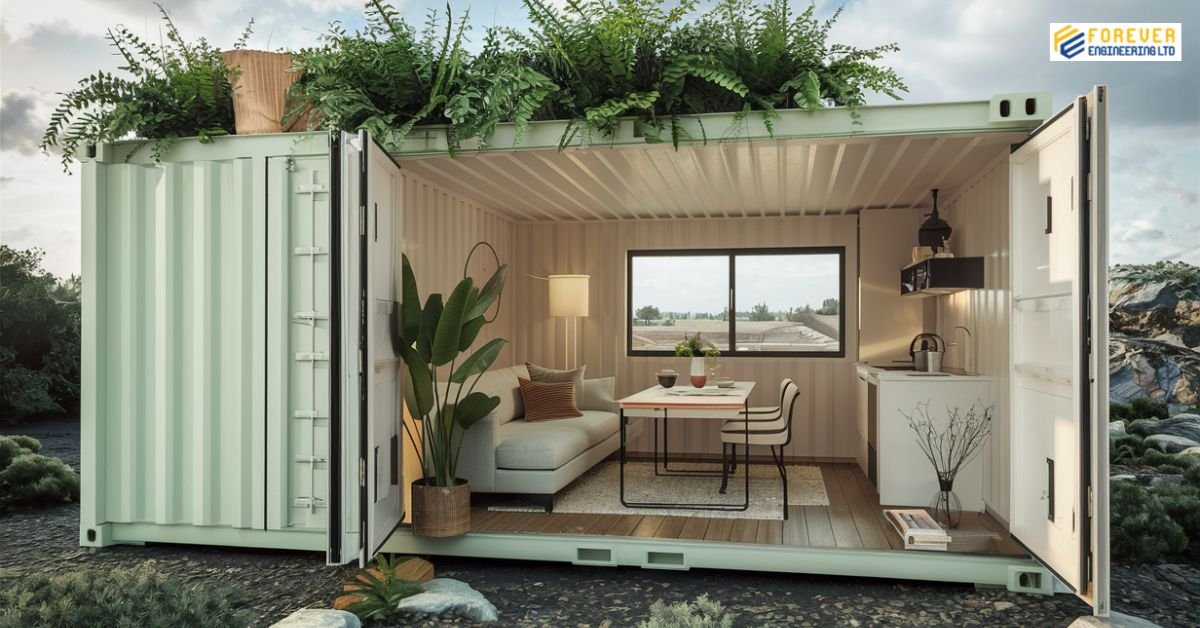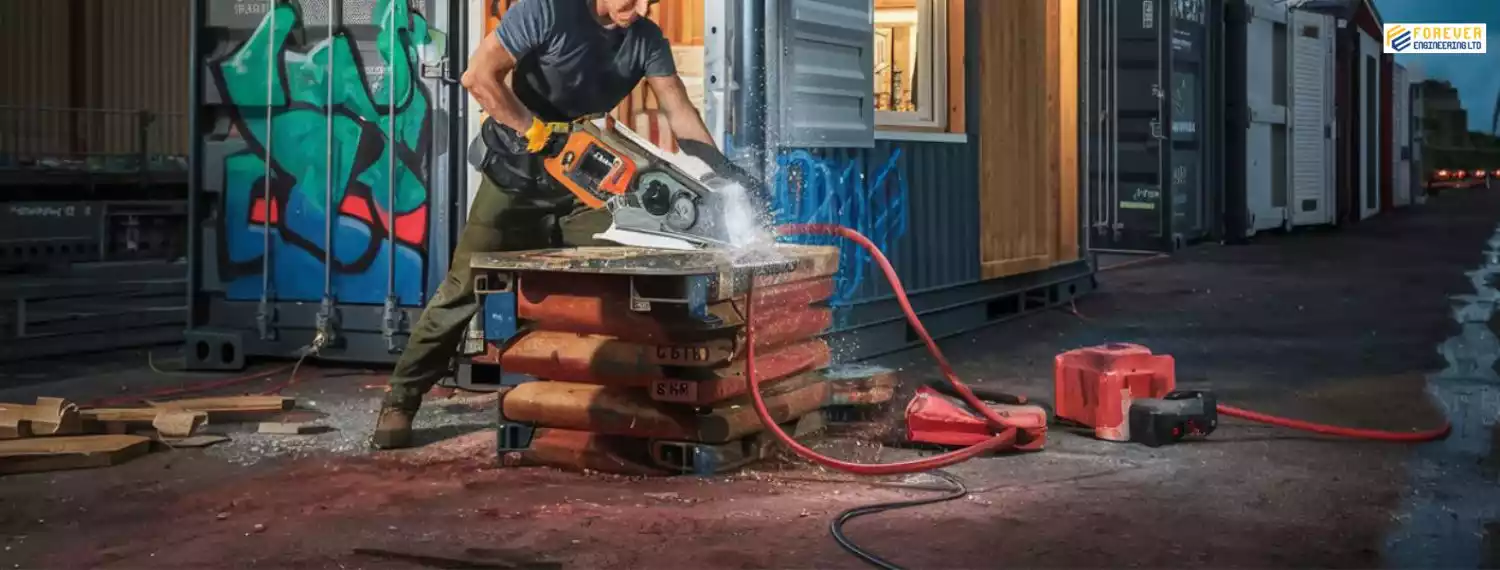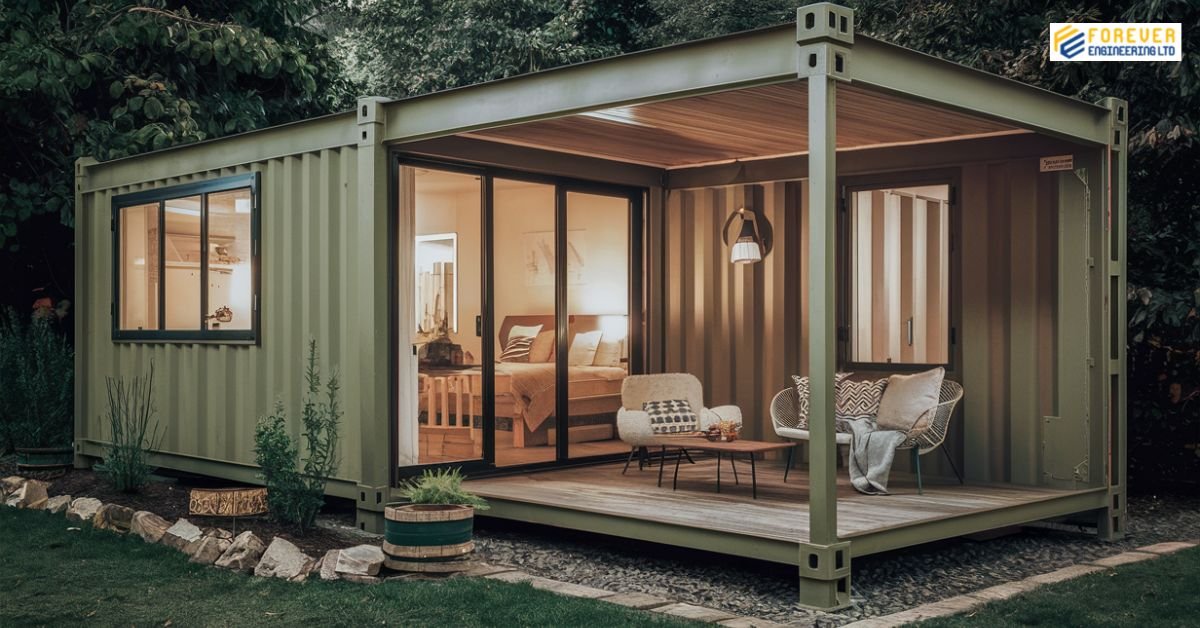Are you wondering how to convert a shipping container into a house? Shipping containers are a cost-effective option for building functional and stylish homes. Their prefabricated structures allow you to construct your dreamy house quickly. This unique, customizable, and portable shipping container can be the perfect choice for creating a truly personalized living space.
Compared to traditional houses, shipping container houses are more portable. Most importantly, they are an eco-friendly and sustainable choice, as you reuse shipping containers and decrease construction waste. This article will teach you how to transform one or multiple shipping containers into a functional house.
How to Turned A Shipping Container into A Luxurious Eco-friendly Home?
Table of Contents
ToggleWhen it comes to converting shipping container to home, you have to follow a step-by-step procedure to build a functional; and modern living space successfully.
The following are the steps to follow to turn shipping container into house.
Step: 01 — Plan Your Home Design
The first important step is planning your home design. Determine what type of house you want to create. How much space do you prefer? How many rooms will be there? How will all rooms be connected?
Moreover, create a sophisticated plan for the bathroom placement and the number of bathrooms. Decide where the windows and doors will be and how many doors and windows will be there.
Also, you want to consider the local building code in your area. It will vary depending on the urban or rural location.
Step: 02 — Discuss With an Engineer
Once you have determined what type of house you want to create, talk with an engineer to learn about the safety and feasibility of your preferred house.
An expert professional can help you build a sturdy, permit-approved home by assessing weight loads, local codes, and foundation needs.
Besides, you will determine the gap between the actual plan and what can be done.
A structural engineer will also help you find potential problems like water leakage, thermal insulation, and wind resistance. This will save you from costly fixes later.
Step: 03 — Choose and Buy the Shipping Container
Shipping containers come in various sizes, from 8 feet to 45 feet in length. But they are only 8 feet wide. However, you can buy customized shipping containers from suppliers like Forever Engineering Ltd.
Besides, you have the option to choose different types of shipping containers. For instance, new high cube containers are in excellent condition and have increased height, but they are expensive.
If you prefer affordable options, used dry storage containers are perfect.
They may need some repair to remove rust and dents, but make sure to consider their structural integrity and potential modifications.
Step: 04 — Prepare Construction Site
The next job is preparing the construction site. You must choose a compatible slab or strip foundation to support the container load.
A reinforced concrete slab is a perfect choice to provide sufficient strength and stability. It can distribute the container’s weight evenly across the ground.
A concrete slab foundation works as a barrier to protect the container from moist soil. Otherwise, it would cause rust issues.
If you are confused about choosing the best base for converting shipping container to home, consult a professional container house supplier.
Step: 05 — Install Your Shipping Container
After choosing appropriate shipping containers to create a home, determine how you will receive them in your preferred location. If you select a reputed shipping container supplier like Forever Engineering Ltd, we will safely deliver and position them.
But, if you buy it from an individual, you must hire a forklift or crane company to move your shipping container. Make sure the particular equipment can handle the load of your shipping container.
Another important thing to consider is securing the shipping container on the foundation. You can use twist locks and ground plate method to adjust your container house. It comes in handy, especially for multiple containers.
However, a welding and steel plate option is better for a permanent solution. Make sure it complies with the regulations in your area.
Step: 06 — Cut Your Openings
The next job is cutting the walls of your shipping containers to create windows, doors, and other parts. It is best to hire a professional to handle the cutting job.
Our expert workforce will use a reciprocating saw or plasma cutter to make clean, straight cuts and form precise openings for doors and windows.
If you have already developed a layout for windows and doors, our people will cut patterns based on the pre-designed layout.
They have in-depth knowledge about proper blade selection, cutting speed, and techniques to create complex shapes.
French doors, sliding glass doors, and steel security doors are the best exterior doors for container houses. Solid core doors, sliding barn doors, and French doors are the top choices of interior doors.
In contrast, awnings, sliders, casement, and fixed (non-opening) are some of the best windows for container houses. Regarding material, you can choose double-pane glass, tempered glass, or polycarbonate windows.

Step: 07 — Remove The Existing Flooring And Add A New One
Most shipping containers have marine-grade plywood floors. They are often treated with harsh chemicals to make them resistant to moisture and other environmental impacts.
Hence, this type of floor is not the best choice for a living space. People who have respiratory sensitivities or children may feel sick from long-term exposure, and this heavy floor is not a perfect choice for keeping heavy furniture.
Hiring a professional team to replace the shipping container floor is best. They will cut through the bolts, secure the plywood panels using reciprocating saws, and carefully pry up the plywood sheets.
Install an appropriate floor for your container house, depending on your preference. You can choose different options, such as laminate, engineered hardwood, vinyl flooring, Luxury Vinyl Tile (LVT), cork flooring, etc.
Before choosing a particular option, consider its durability, comfort, moisture resistance capabilities, style, and weight.
Step: 08 — Add Framing And Sheathing Material
Internal framing is necessary to provide structural support for your container house. You must also modify the original structure and form doors and windows.
Timber framing is a good choice if you prefer a cost-effective option. However, steel framing is the best pick due to its versatility, durability, and fire-resistant capabilities. Before choosing a particular framing option, consider your budget, project complexity, and desired aesthetics.
Besides, you want to add appropriate sheathing to weatherproof the corrugated steel walls and provide structural reinforcement. It will also smooth the interior container walls and ensure better electrical and plumbing integration.
Step: 09 — Add Appropriate Insulation Material
You can choose a different option When insulating a shipping container house. Of course, you must recognize the importance of the surrounding climate needs.
Spray foam insulation is a decent choice to minimize air leaks and maintain a seamless, high-density layer.
But fiberglass batts are a cost-effective option. Don’t expect it to be as good as spray foam insulation. It may leave some gaps and cracks between batts.
Another popular option is rock wool insulation. It appears appropriate if you prefer fire-resistant, moisture-resistant, and soundproof insulation options. However, its insulation capabilities will degrade over time.
Step: 10 — Decorate the Interiors
After setting up the main container house, you can now decorate the interiors to make the entire house functional and stylish. Add different interior elements for bedrooms, bathrooms, kitchen, and living room.
You can add a shoe rack, coat hooks, and a small bench for sitting on the entryway. If your container house has limited space, install built-in shelves, cabinets, and ottomans to utilize the space.
In addition, you can keep a washer and dryer in a separate laundry room. Before adding any interiors, consider factors like floorplan, storage, plumbing and electrical items, natural light and ventilation.

A Top Shipping Container House Supplier in Bangladesh
Building a house from one or several shipping containers requires in-depth knowledge of different fields. After all, it involves several complex tasks. Forever Engineering Ltd. can help you if you need clarification about starting such a renovation project.
We are one of the best container house suppliers in Bangladesh. Our expert professional team can build customized shipping container houses based on our client’s needs. We also sell standard and customized container offices and container restaurants.
Services of Forever Engineering Ltd in Building Container House
Apart from making and customizing the main shipping container house, we can add interior elements for our clients, such as lighting and power, air conditioning, personnel door access, windows and shutters, insulations, framing, kitchen, parking, etc.
Our experts will consider your shipping container house’s dimensions, pre-planned layout, container weight capacity, plumbing and electrical placement, aesthetics and functionality, ventilation and airflow, furniture arrangement, and many other factors before adding any internal elements inside the shipping container house.
Frequently Asked Questions (FAQ’s)
The timeline can vary widely depending on the complexity of the design and the extent of the modifications. Generally, a basic conversion can take a few days, while more complex projects might take a month or more.
Yes, when properly insulated and designed with energy efficiency in mind, shipping container homes can be quite energy-efficient. The use of solar panels, rainwater collection systems, and other sustainable features can further enhance their efficiency.
Yes, in Bangladesh, you can construct a shipping container home on various types of terrain, ensuring the land is stable and appropriate for building to secure the structure’s durability and safety.
The cost can vary widely depending on factors like the size of the container, the extent of modifications, and the quality of finishes. Basic conversions can start at around BDT 140,000 while more elaborate designs can exceed BDT 9,900,000.
Container homes can be more sustainable than traditional homes due to their use of recycled materials and potential for smaller environmental footprints. Incorporating sustainable practices, such as solar panels or rainwater harvesting, can further enhance their eco-friendliness.
Conclusion
Shipping container homes embody innovation, sustainability, and affordability. By considering the essential steps and challenges outlined in this guide, you’re well on your way to creating a unique home that not only meets your needs but also contributes positively to the environment. With creativity, careful planning, and a commitment to sustainability, the dream of living in a shipping container home can become a reality, providing a comfortable and stylish space that reflects your values and lifestyle.


